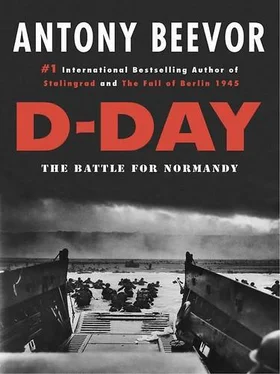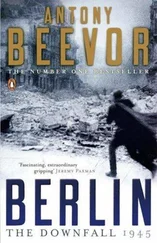Hitler had given the task of improving the Channel defences to Generalfeldmarschall Erwin Rommel, the commander-in-chief of Army Group B. Rommel, a former Hitler loyalist, had become dejected by the effects of Allied air superiority in North Africa. The energetic panzer commander who had been made a national hero now referred cynically to Hitler’s mesmerizing pep talks aimed at depressed generals as ‘sun-ray treatments’. But Rommel never slackened in his attempts to improve the coastal defences.
The most obvious target of all was the Pas-de-Calais. This offered the Allies the shortest sea route, the greatest opportunity for constant air support and a direct line of advance to the German frontier less than 300 kilometres away. This invasion, if successful, could cut off German forces further west and also overrun the V-1 launching sites, which would soon be ready. For all these reasons, the main defences of the whole Atlantic Wall had been concentrated between Dunkirk and the Somme estuary. This region was defended by the Fifteenth Army.
The second most likely invasion area consisted of the Normandy beaches to the west. Hitler began to suspect that this might well be the Allied plan, but he predicted both stretches of coast so as to make sure that he could claim afterwards that he had been right. The Kriegsmarine, however, bizarrely ruled out the Normandy coastline in the belief that landings could be made only at high tide. This sector, running from the Seine to Brittany, remained the responsibility of the German Seventh Army.
Rommel chose as his headquarters the Château de la Roche-Guyon, which lay on a great bend of the River Seine, which marked the boundary between his two armies. With chalk cliffs behind and a ruined Norman stronghold on the heights above, it looked down across the parterres of a famous herb garden to the great river below. The Renaissance entrance set in medieval walls seemed entirely fitting for the seat of the Rochefoucauld family.
With Rommel’s permission, the current duke and his relations kept apartments on the upper floor of the great house. Rommel seldom used the state rooms apart from the grand salon, with its magnificent Gobelin tapestries. There he worked, looking out over a rose garden not yet in flower. His desk had been the one on which the revocation of the Edict of Nantes had been signed in 1685, a measure which had sent the Huguenot ancestors of many Wehrmacht officers to seek new lives in Prussia.
Rommel seldom spent daylight hours at the château. He usually rose at five, breakfasted with Generalleutnant Hans Speidel, his chief of staff, then set out immediately on tours of inspection in his Horch staff car, accompanied by no more than a couple of officers. Staff conferences were held in the evening on his return, then he dined frugally with his closest entourage, often just Speidel and Konteradmiral Friedrich Ruge, Rommel’s naval adviser and friend. Afterwards, he would continue the discussion with them outside, strolling under two huge cedar trees. They had much to talk about in private.
Rommel was exasperated by Hitler’s refusal to bring the Luftwaffe and Kriegsmarine under a centralized command for the defence of France. Encouraged by Göring and Admiral Dönitz, Hitler instinctively preferred to maintain rival organizations which only he could control from the top. Speidel argued that the Luftwaffe had more than a third of a million ground staff and signals personnel in the west, all part of Göring’s empire building. To make matters worse, the Reichsmarschall refused to put his flak corps at the service of the army, which his own aircraft could not defend from Allied air attack.
Whenever Rommel complained of the uselessness of the Luftwaffe, Führer headquarters would try to impress him with the prospect of a thousand new jet fighters and countless rockets to bring Britain to its knees. Not only did he refuse to believe these promises, he knew that his hands were tied operationally. Ever since the Battle of Stalingrad, Hitler had not allowed a flexible defence. Every inch of ground must be held.
Speidel, a member of the army’s resistance movement, recorded that Rommel himself bitterly quoted Hitler’s own dictum in Mein Kampf from the days of the Weimar Republic: ‘When the Government of a nation is leading it to its doom, rebellion is not only the right but the duty of every man.’ Rommel, however, unlike Speidel and the plotters in Berlin motivated by Oberst Claus Schenk Graf von Stauffenberg, did not believe in assassination.
The elderly Rundstedt, on the other hand, while constantly referring in private to Hitler as ‘that Bohemian corporal’, would never have contemplated revolt. If others were to remove the Nazi ‘brown band’, then he would not stand in their way, but he would certainly not commit himself. His ambivalence went deeper. Rundstedt had accepted massive amounts of money from Hitler and must have felt compromised as a result. But even Speidel underestimated the depths to which Rundstedt would sink after the attempted revolution against Hitler failed.
Rundstedt had become almost as much a figurehead of the army and nation as Generalfeldmarschall von Hindenburg after the First World War. The British regarded ‘the Last Prussian’ as nothing more sinister than a reactionary Guards officer and failed to appreciate that he shared many of the Nazis’murderous prejudices. Rundstedt had never objected to the mass murders of Jews by the SS Einsatzgruppen on the eastern front. He had then spoken of the advantages of using the Russian slave labourer in France. ‘If he does not do as he is told,’ he said, ‘he can quite simply be shot.’
Rundstedt’s dismay over Hitler’s disastrous conduct of the war had turned into a lethargic cynicism. He showed little interest in the theory of panzer tactics and held himself aloof from the fierce debate over the best way to fight the invasion. This was conducted mainly between Rommel on the one hand, who wanted a forward defence to defeat the Allies as they landed, and the two leading proponents of a massive armoured counter-attack on the other: Generaloberst Heinz Guderian, the inspector-general of panzer troops, and General der Panzertruppen Leo Freiherr Geyr von Schweppenburg.
Geyr, a former military attaché in London who bore a certain resemblance to Frederick the Great, was rather more cultivated than many of his contemporaries. His intellectual arrogance, however, made him a number of enemies, especially within Führer headquarters and the SS, who suspected his loyalty to the regime. As commander-in-chief of Panzer Group West, Geyr believed with Guderian that a panzer army should be assembled in the forests north of Paris ready to smash the enemy back into the sea.
Rommel, who first made his name as a bold panzer leader in 1940, had since been profoundly influenced by his experiences in North Africa. And now that the Allies had achieved total air supremacy over north-west Europe, he believed that panzer divisions held back from the front for a counter-attack would never be allowed to reach the battle in time to ensure a decisive result. Predictably, a bad compromise was the result of Hitler’s insistent meddling and the confused command structure. Neither Geyr nor Rommel had control over all the panzer divisions, because Hitler would only permit them to be deployed with his approval.
Increasingly convinced that the Allies might well land in Normandy after all, Rommel visited the coastal defences there frequently. He thought that the long curving bay which the Allies had designated as Omaha beach was similar to Salerno, where they had landed in Italy. Certain that the outcome would be decided in the first two days, Rommel was tireless in his efforts. Turrets from French tanks captured in 1940 were fixed to concrete bunkers. They were known as ‘Tobrouks’, from the battle in North Africa. French labourers and Italian prisoners of war were drafted in to erect large posts to thwart glider landings on the most likely sites identified by German paratroop officers. These forests of stakes were nicknamed ‘Rommel asparagus’.
Читать дальше











